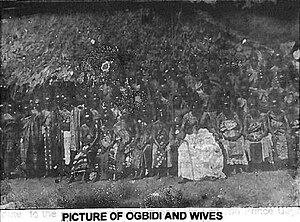| HRH Okojie Okolo N'Ogbidi | |
|---|---|
| Onojie of Uromi | |
| Reign | 1857–1944 |
| Coronation | 1900 |
| Predecessor | Okolo N'Ojie |
| Successor | Uwagbale |
| Born | 1857 (1857) Uromi |
| Died | 3 February 1944(1944-02-03) (aged 86–87) Uromi |
| House | Okojie Royal Dynasty |
| Father | Okolo N’Ojie |
| Mother | Queen Mother Agbon-ilolo Okolo |
Ogbidi Okojie, Onojie (king) of Uromi (1857 – 3 February 1944), was a ruler of the Esan people in what is now Edo State in Nigeria, still remembered for his opposition to British rule.

Biography
According to Uromi lore, he was born in the seventh month of gestation, coming 14th in the line of succession to the Uromi throne. As an African monarch, he believed in his divine right to wield absolute power. Those beliefs motivated his opposition to British Rule, which led to his first exile to Calabar in 1900. In Nigeria, at the end of the nineteenth century, the old order was crumbling, yielding to the new British colonial system. After the Royal Niger Company transferred its territories to the British government, the latter expanded and strengthened its control, unseating the traditional rulers. In 1900, Uromi was invaded by the British troops. Unlike Chief Nana Olomu of Brohimie-Warri, who opposed a strong resistance to the British troops when his domain was invaded, with 100 cannon, several shot-guns and more than 5,000 slaves at his disposal, Okojie I, who had no modern weapons, but only Dane guns, bows and arrows, held out for six months, until he was betrayed by Iyahanebi, his "younger brother", and had to surrender to the British. As a consequence of his stiff resistance, in 1900 he was exiled to Calabar, where he met Oba Ovonramwen, late Oba of Benin, who had been exiled there by the British.
He survived the ordeal in detention and returned home to be crowned the 14th Onojie of Uromi in 1900. Back home in Uromi, he adapted to the British system of government through "indirect rule", establishing his court at Ubiaja as the Divisional Supreme Judge. Still, he did not fully accept the new system of government, countering it with passive disobedience and maintaining his opposition to British rule. He kept governing his subjects as his forebears had always done, until he was deported again, this time to Benin, in 1918. His presence in Benin unsettled Oba Eweka II, the then ruling Oba, who objected to the British Resident at Benin against Okojie's presence there. In 1924, he was transferred to Ibadan. In 1926, he made a dramatic escape to Uromi, was arrested and taken back to Ibadan, until he was finally released in 1931. From 1931 until his death in 1944 he consolidated his power in Uromi. His first son Prince Uwagbale Okojie was crowned Onojie of Uromi in 1944.
While alive, he was highly influential in Esan, Agbor and Benin City. In Esan he was the supreme judge of the criminal court that sat and tried murder cases at Agbede, Esan, Kukuruku (now known as Auchi) and Ologhodo (now Agbor). He built schools and supported higher learning. He built the roads from Uromi to Ilushi, Agbor and Ehor. When he died, he left behind an undisputed heir to the throne, glorious memories of life in exile and the fulfillment of his aspiration for renewed independence for black Africa and Nigeria. These prompted the Nigerian founding father Chief Anthony Enahoro, one of his many grandchildren, in to initiate the self-government motion in the Western House of Assembly in 1953, which eventually led to Nigerian Independence on 1 October 1960. A younger grandson is Peter Enahoro, revered pan-African journalist and author of How to be a Nigerian (1966). Other grandchildren include Cardinal Anthony Okogie, the first Esan Cardinal, Dr. Robert Okojie, a NASA scientist, amongst others based in the U.S.
Okojie I, the Onojie of Uromi, was survived by over sixty wives, over forty concubines, and innumerable children and grandchildren. He is still remembered by his people as Ogbidi the Uromi umbrella, the white son of Olokun, Okun the greatest native doctor that ever lived and ruled the native people of Uromi, who can turn into a girl, a lion or a leopard at will, the great doctor who can command the rain to fall and the air to stand still.
Although he died many years ago, his legacy continues in many different parts of the world, from North America to Europe to Australia, where his grandchildren and great grandchildren currently reside.
See also
References
- Project, African Docs (2022-06-15). "The Life and legacy of Ogbidi Okojie (King of Uromi, Nigeria)". African Docs. Retrieved 2023-01-29.
- C.O. Aluede and A.A. Braimah op.cit. p.127
- J.U. Egharevba, "A Short History of Benin", Ibadan University Press, 1968.
- Okojie, A.T.A. "HRH OKOJIE I: The Man, the Myth and the Symbol" Lagos, Kope Publishers, 1997.
- "Tenancity of Gerontocracy in Nigeria – An Example of the Esan People in Edo State" by Anthony I. Okoduwa, Stud. Tribes Tribals, 3(2): 123–128 (2005).
- "Edo Folk Songs as Sources of Historical Reconstruction" by Charles O. Aluede and Abu A. Braimah, Stud. Tribes Tribals, 3(2): 123–128 (2005).
- Uromi Community New York – http://www.uromicommunity-ny.com/aboutus.html
- The Travails of King Okojie -http://oer.sau.edu.ng/Uploads/Journals/the-travails-of-king-okojie-and-politics-of-centrifugal-and-centripetal-forces-in-colonial-uromi-ishan-division-of-benin-province-nigeria-1919-1931.pdf